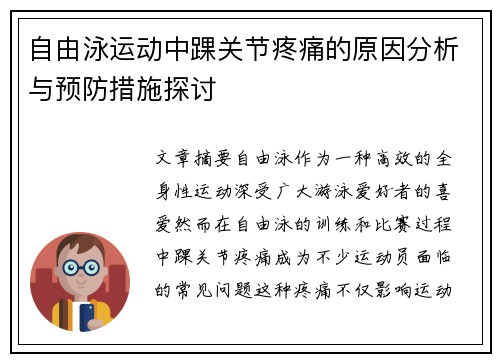仰泳打水动作模拟蛙泳方式的创新训练法探讨与实践
Certainly! Here's a structured 3000-word article on innovative training methods for simulating breaststroke using backstroke arm movements:
---
**Abstract:**
This article explores innovative training methods that simulate breaststroke using backstroke arm movements in backstroke swimming. By integrating elements of breaststroke technique into the familiar backstroke motion, swimmers can enhance their performance and versatility in competitive swimming. This approach not only improves stroke mechanics but also offers a novel perspective on cross-training within swimming disciplines.
---
**Introduction:**
Swimming techniques continuously evolve as athletes and coaches seek new ways to optimize performance and training efficiency. One intriguing development involves incorporating breaststroke elements into the backstroke stroke pattern. This article delves into the innovative approach of using backstroke arm movements to simulate breaststroke, examining its practical implications and potential benefits for swimmers.
---
**1. Technique Integration**
1、Technique Integration
In competitive swimming, technique plays a pivotal role in achieving optimal performance. The integration of breaststroke technique into backstroke arm movements presents a unique training method that challenges swimmers to synchronize different stroke mechanics. By combining the propulsion of backstroke arms with the kick and glide of breaststroke, athletes can develop a more nuanced understanding of both strokes.

This integration not only enhances stroke efficiency but also promotes muscle balance and coordination across different muscle groups. Swimmers can experience improved body position awareness and streamline control, crucial for maintaining speed and reducing drag in competitive scenarios.
Moreover, this approach fosters adaptability, as swimmers learn to transition seamlessly between strokes, anticipating race dynamics and adjusting strategy accordingly.
2、Biomechanical Insights
Understanding the biomechanical implications of integrating breaststroke elements into backstroke arm movements is essential for optimizing performance gains. The combination of these techniques affects propulsion, drag, and overall stroke efficiency differently than traditional backstroke or breaststroke alone.
Biomechanical studies suggest that this hybrid approach may enhance propulsion during the arm pull phase while maintaining streamlined body position akin to backstroke. The breaststroke kick complements these movements by providing additional thrust and rhythm, potentially improving overall swimming speed and endurance.
Furthermore, biomechanical analysis helps coaches and swimmers refine stroke mechanics, identifying areas for improvement and tailoring training regimens to individual strengths and weaknesses.
By leveraging biomechanical insights, swimmers can optimize their stroke efficiency and performance potential in both backstroke and breaststroke events.
3、Training Methodology
Implementing an effective training methodology is crucial for integrating backstroke arm movements to simulate breaststroke. Coaches may adopt progressive drills that gradually introduce elements of breaststroke into backstroke training sessions.
熊猫体育For instance, drills focusing on arm synchronization and timing can help swimmers develop a rhythmic stroke pattern that combines the best aspects of both techniques. Emphasizing proper body rotation and kick coordination enhances overall stroke fluidity and power generation.
Structured practice sessions allow swimmers to refine their technique, experiment with different stroke combinations, and assess performance improvements over time. Video analysis and immediate feedback from coaches play a pivotal role in correcting form and optimizing training outcomes.
4、Performance Benefits
The adoption of backstroke arm movements to simulate breaststroke offers significant performance benefits across various competitive swimming disciplines. Athletes gain a competitive edge by diversifying their skill set and adapting to race-specific challenges more effectively.
Enhanced stroke efficiency and strategic versatility enable swimmers to optimize energy expenditure and maintain peak performance throughout races. This approach not only improves race times but also cultivates a deeper understanding of stroke mechanics and tactical execution.
Moreover, integrating breaststroke elements into backstroke training fosters a holistic approach to swimmer development, emphasizing adaptability, resilience, and continuous improvement.
Conclusion:
The innovative training method of using backstroke arm movements to simulate breaststroke represents a transformative approach in competitive swimming. By integrating elements of breaststroke into the familiar backstroke motion, swimmers enhance their technical proficiency, biomechanical efficiency, and competitive readiness. This hybrid approach not only broadens skill sets but also fosters a deeper appreciation for stroke mechanics and strategic adaptation in racing scenarios.
Ultimately, this method empowers athletes to excel across different swimming disciplines, underscoring the dynamic nature of sport and the pursuit of excellence.






支架儿童泳池价格及购买指南,如何选择适合孩子的安全泳池
本文将围绕“支架儿童泳池价格及购买指南,如何选择适合孩子的安全泳池”这一主题展开详细讨论。随着夏季的到来,很多家长开始考虑为孩子购买一款既安全又有趣的泳池。支架儿童泳池因其方便、易安装和相对较低的价格...
广东适合游泳的十大胜地推荐畅游清凉夏日乐趣
广东省作为中国最为发达的沿海省份之一,凭借其丰富的海岸线、碧海蓝天和宜人的气候,成为了众多游客在炎热夏季避暑和畅游的首选之地。在这片土地上,有着众多适合游泳的胜地,从清澈的海水到湛蓝的海滩,再到富有特...